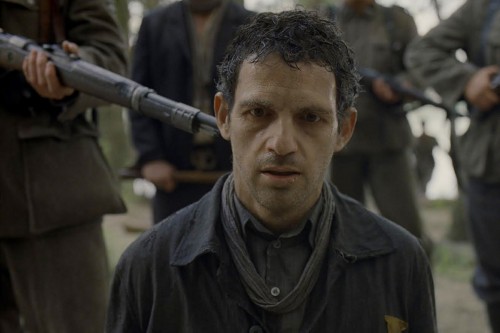Son of Saul: The Blur of War, by David Bax
There are so many movies about the Holocaust that it can be tempting to develop a fatigue around the subject matter. But the enormity of the atrocity remains so incomprehensible that even another seven decades of stories couldn’t fill out a full picture of it. That’s especially true when films like László Nemes’ Son of Saul find interesting new ways to approach the topic, even if they don’t necessarily uncover new themes. The film is both an unflinching and disturbingly realistic account and also a bit of a formal experiment. With often powerful results, it mostly succeeds at both.
Géza Röhrig plays Saul, an Auschwitz prisoner whose job at the camp is to collect valuables from the discarded clothes of those herded naked into the gas chambers and then, after they’ve been killed, to go in and help clear out the bodies. After one session, a boy is found to be still clinging to life. Of course, the Germans immediately suffocate him but Saul takes it upon himself to give the child a proper burial, claiming him as his son. This is no easy task, requiring Saul to steal the body and seek help from a variety of other prisoners, all while new men, women and children flood into the camp to be killed as Germany scrambles in the final days of the war and some of Saul’s cohorts plan an escape.
Nemes’ stylistic gambit is to shoot in a 1.37:1 aspect ratio with only a 40mm lens. Saul is nearly always the main subject of the jittery and anxious handheld frame, very often in close-up, with the background out of focus.
There are some unfortunate drawbacks to this approach. The most notable is that, due to the lack of contextual information available in the blurry background, certain bits of exposition have to be awkwardly spoken by offscreen characters. Most often, this is done by German guards and soldiers explaining – plainly for the sake of the viewer – what is going on. The prisoners shoveling the ashes of the dead into the river don’t need to be told that’s what they’re doing. Nemes just wants to make sure we know.
Still, Nemes’ aesthetic decisions have more fruitful effects overall than deleterious ones. There are constant horrors in the camp. From the gas chamber victims seen both before and after to the executions by bullet on the lip of a mass grave when the number becomes too many for the chambers to handle to the chillingly commonplace incidental acts in between, Saul is in the unending presence of evil. That we can’t quite see these things clearly makes them all the more atrocious. The abomination of the Holocaust burns like the sun and it would be impossible to look directly at it. Instead, we look at Saul’s face, an ever-present reminder of the humanity at stake. The methodology described may sound like something from a Dardenne brothers film but the intensity has more in common with Children of Men or Lodge Kerrigan’s underappreciated Keane.
Saul’s journey to find a resting place for the dead boy takes us on a tour of the killing factory of the concentration camp. After the gassing, we see the room where gold fillings are ripped from the mouths of the dead and the bodies are burned and then onto the aforementioned disposal of ashes. This is mass murder as a machine and Nemes’ strict focus on Saul offers a juxtaposition of individuality and the struggle to maintain it in such a setting. Saul is constantly being grabbed by the arm or shoulder and thrust in different directions but he is somehow able to disconnect and center on the sacred task that he believes is of paramount importance. Sometimes Saul’s single-mindedness causes harm to others and sometimes he is able to accomplish some good. Through it all, though, he remains himself. Son of Saul presents that as a gargantuan moral victory in the face of incomprehensible evil.




























